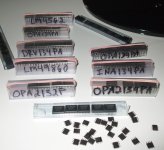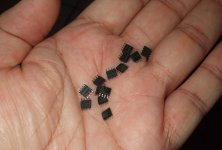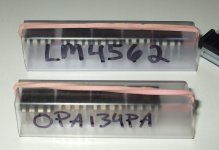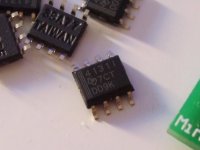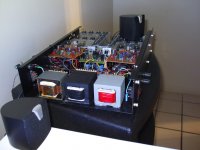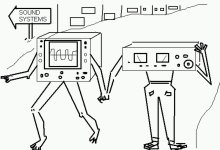...There’s no problem about you Ultima Thule..you are not such
kind of guys, but your question made me suspect you may be addicted
to such kind of group of ideas…. ...
hahaha thats ok!
You manage to make a second reply while I was typing on my reply...
sure I understand what you mean, some times we should all be able to relax and just listen to music, and not the amplifier!

Cheers Michael
PS: Carlos, I'm very happy you got the Olympics 2016!
Last edited:
the ratio is 60 percent to the woofer, 30 percent to the midrange and 10 percent to the tweeter....in watts this means 60 watts, 30 watts and 10 watts
That is the wrong conclusion. The reason, why you need less power for the tweeter, than for the woofer lies in their different sensitivities. Your tweeter has easily a 10 dB higher sensitivity than the woofer. That is, why you need about ten times the power for the woofer than for the tweeter.
The 60/30/10 ratio describes, how the load is distributed. If you had three drivers with the same sensitivities, they would need the same 100 W peak amplifier power for a flat frequency response. But their average power handling would be 60 W for the woofer, 30 W for the mid-range and 10 W for the tweeter.
The sensitivity changes that ratio. If you use a tweeter with 10 dB higher sensitivity in that configuration, it only needs 10 W peak amplifier power and 1 W average power rating.
Thank you Ultima Thule..you are very welcome
Yeah Ultima.... we've got the Olimpics..we gonna be the town..we are extremelly proud of that....happy as a morning bird because of that...in special we have winned Madrid...and we all know was a huge battle to win Madrid!.
In the Dog's face hill, under the rigth ear, they found Viking letters saying someone that died and was buried there.
a hug to you Ultima...we have to take that drink around the swiming pool....do you remember?
Carlos
.......................................................................................................................................
You're wrong PacificBlue.... try to do it, build something alike, and you will see that even driver's sensitivity will not be the issue to balance a lovely system.
be happy!
Carlos
Yeah Ultima.... we've got the Olimpics..we gonna be the town..we are extremelly proud of that....happy as a morning bird because of that...in special we have winned Madrid...and we all know was a huge battle to win Madrid!.
In the Dog's face hill, under the rigth ear, they found Viking letters saying someone that died and was buried there.
a hug to you Ultima...we have to take that drink around the swiming pool....do you remember?
Carlos
.......................................................................................................................................
You're wrong PacificBlue.... try to do it, build something alike, and you will see that even driver's sensitivity will not be the issue to balance a lovely system.
be happy!
Carlos
Attachments
Last edited:
Those passive filters uses low voltage capacitors, and they use to be very cheap....also a single resistance or two will not be expensive.
What i do not know, for a while, is the sonic advantage for passive or active...i have to assemble both and compare.
Active can have higher level of attenuation, i do not know if i need that or not..i suppose not.
Passive distorts...but integrated circuit also distorts.
Passive does not need supply, when active will need a 12 volts symetrical supply.
I am not sure...but i think passive is natural.... seems more simple... and simple use to be better...we gonna see in the future.
Also, all of you can try and post your thougths about.
regards,
Carlos
Hello Carlos
Wen it's possible, I prefer to use passive filters, because active filter use op-amps and those do have a kind of sound signature and op-amp mostly need lot of feedback. If you need to use active filter use Bessel type to get better transient response.
Bye
Gaetan
Last edited:
I do feel this way.... i will produce active too, because a friend asked
and i will be sure about all those things....i am not sure, there are some "attraction".....there are something very fashion when we use op amps...people believe high technology is hidden inside those black cases...big black magic there!....you know.... imagination can feed all kind of people needs.... whatever people wants.
In the reality, inside op amps we have an audio amplifier..with differential input (modified), voltage amplifier single or symetrical, drivers and output..all that stuff and an enormous ammount of ccs, mirrors, current sinks, stabilizers, impedance matchers (buffers) and so on..... in my imagination, all that stuff may distort more than resistances and capacitors...but...i am not sure in advance to build and test.
regards dear Gaetan.
à bientôt
Charles
and i will be sure about all those things....i am not sure, there are some "attraction".....there are something very fashion when we use op amps...people believe high technology is hidden inside those black cases...big black magic there!....you know.... imagination can feed all kind of people needs.... whatever people wants.
In the reality, inside op amps we have an audio amplifier..with differential input (modified), voltage amplifier single or symetrical, drivers and output..all that stuff and an enormous ammount of ccs, mirrors, current sinks, stabilizers, impedance matchers (buffers) and so on..... in my imagination, all that stuff may distort more than resistances and capacitors...but...i am not sure in advance to build and test.
regards dear Gaetan.
à bientôt
Charles
Man!... i have several
Here you will see some of them... also i have the 4558 and 4560 and some numbers alike... the old family.
Some are alike small bugs...hard to hold between the fingers...i really do not like that stuff!... to read the numbers i have to find magnified lenses.
regards,
Carlos
Here you will see some of them... also i have the 4558 and 4560 and some numbers alike... the old family.
Some are alike small bugs...hard to hold between the fingers...i really do not like that stuff!... to read the numbers i have to find magnified lenses.
regards,
Carlos
Attachments
Last edited:
Hello Carlos
Same for me, I don't like those SMD Ic's, they are so small.
The 4558 and 4560 are not very good.
LM5532 and LM5534 are old but good, you can bias them in class A.
The LM4562 are very good but need good decoupling.
There was a good page about op amps but was close, but here is the page in
web archive;
Opamp Design
Bye
Gaetan
Same for me, I don't like those SMD Ic's, they are so small.
The 4558 and 4560 are not very good.
LM5532 and LM5534 are old but good, you can bias them in class A.
The LM4562 are very good but need good decoupling.
There was a good page about op amps but was close, but here is the page in
web archive;
Opamp Design
Bye
Gaetan
post 93 is completely wrong.
This requires one to look at driver sensitivity and from there to determine the voltage required by each driver to achieve your chosen peak SPL.
Only after doing that can you determine the amplifier power or voltage or current specifications.
The ratio of average powers in different frequency bands in typical music (or other audio sources) has absolutely nothing to do with the power requirements of the speakers.
Design for peak SPL!
eg.
three drivers with the following spec
8ohm Bass 85dB/W/m
8ohm Mid 88dB/W/m
8ohm Treble 94dB/W/m
Bass requires 40Vpk to produce 100dB @ 2.5m
Mid requires 28.3Vpk to produce 100dB @ 2.5m
Treble requires 14.2Vpk to produce 100dB @ 2.5m
This equates to 100W into 8r0 for a bass amplifier, 50W into 8r0 for a mid range amplifier and 13W into 8r0 for a treble amplifier.
Change the driver sensitivities and the calculation MUST be repeated, inserting the new voltages for peak SPL.
the system output requires the drivers' peak SPL to be approximately the same for all frequencies........................................................................................................................................
You're wrong PacificBlue.... try to do it, build something alike, and you will see that even driver's sensitivity will not be the issue to balance a lovely system.
This requires one to look at driver sensitivity and from there to determine the voltage required by each driver to achieve your chosen peak SPL.
Only after doing that can you determine the amplifier power or voltage or current specifications.
The ratio of average powers in different frequency bands in typical music (or other audio sources) has absolutely nothing to do with the power requirements of the speakers.
Design for peak SPL!
eg.
three drivers with the following spec
8ohm Bass 85dB/W/m
8ohm Mid 88dB/W/m
8ohm Treble 94dB/W/m
Bass requires 40Vpk to produce 100dB @ 2.5m
Mid requires 28.3Vpk to produce 100dB @ 2.5m
Treble requires 14.2Vpk to produce 100dB @ 2.5m
This equates to 100W into 8r0 for a bass amplifier, 50W into 8r0 for a mid range amplifier and 13W into 8r0 for a treble amplifier.
Change the driver sensitivities and the calculation MUST be repeated, inserting the new voltages for peak SPL.
Last edited:
This is adjusted using ears Andrew t...listening you know
This is exactly to avoid the need of too much calculations and details, or home acoustics, or speaker sensitivities, or musical taste..... you have knobs to adjust your taste..including the amplifiers have trimpots to adjust sensitivity too.
So..there's nothing wrong..it is all rigth and fine, sounding great.
regards,
Carlos
This is exactly to avoid the need of too much calculations and details, or home acoustics, or speaker sensitivities, or musical taste..... you have knobs to adjust your taste..including the amplifiers have trimpots to adjust sensitivity too.
So..there's nothing wrong..it is all rigth and fine, sounding great.
regards,
Carlos
My dear friends... the Dx TriAmp system is made to be flat to your ears
to make your ears feel sound flat...... or better is to say, nice and pleasant to your ears, compensating your home acoustics, your speaker characteristics, to be rid from specifications, to be free from speaker sensitivity and efficiency... you adjust to your music style setting all tone potentiometers half way...then you can misadjust the way you want, to each music style, beeing happy with the sound you listen and not bothering if is increasing or loosing some decibels here or there.... you just adjust to feel good.
This amplifier is the "living calculator machines" nightmare... depending my amplifier they will loose their jobs, as no rule is appliable.... all is adjusted to your taste...flat for you..for you ears and your heart.
As i use to say... my amplifiers were not made to instruments listen...they are made for humans, to be pleasant....i do not care if loosing a milivolt here or if something is out from the academic standards..... sound for you, not for the "standards".
be happy!
Carlos
to make your ears feel sound flat...... or better is to say, nice and pleasant to your ears, compensating your home acoustics, your speaker characteristics, to be rid from specifications, to be free from speaker sensitivity and efficiency... you adjust to your music style setting all tone potentiometers half way...then you can misadjust the way you want, to each music style, beeing happy with the sound you listen and not bothering if is increasing or loosing some decibels here or there.... you just adjust to feel good.
This amplifier is the "living calculator machines" nightmare... depending my amplifier they will loose their jobs, as no rule is appliable.... all is adjusted to your taste...flat for you..for you ears and your heart.
As i use to say... my amplifiers were not made to instruments listen...they are made for humans, to be pleasant....i do not care if loosing a milivolt here or if something is out from the academic standards..... sound for you, not for the "standards".
be happy!
Carlos
No,This is exactly to avoid the need of too much calculations
it's not a reason to miss out the arithmetic.
The philosophy is wrong.
Go back to the example and change the driver sensitivities from those shown to 8ohm, 90dB/W/m.
To obtain the same 100dB @ 2.5m, all three drivers require 22.5Vpk. This can be provided by using three 35W into 8ohm amplifiers.eg.
three drivers with the following spec
8ohm Bass 85dB/W/m
8ohm Mid 88dB/W/m
8ohm Treble 94dB/W/m
Bass requires 40Vpk to produce 100dB @ 2.5m
Mid requires 28.3Vpk to produce 100dB @ 2.5m
Treble requires 14.2Vpk to produce 100dB @ 2.5m
Note that the drive voltage of all three amplifiers is the same, but the heatsinks and PSU and output stage can and will be quite different due to the average power demand of the various drivers. The treble will demand very short term transients that can be easy met with a small capacitor bank fed from a smaller transformer through a single pair output stage.
The Bass driver could demand continuous low frequency current that will require a larger transformer and greater capacitance and a robust two or three pair output stage that can maintain many amps for many seconds without overheating.
The mid driver could use an amplifier with a physical structure between the two extremes.
BUT I REPEAT, all amplifiers are capable of the same power output for drivers that have the same impedance and sensitivity.
Hi Andrew,
I support your view FULLY. If you want the same SPL from all drivers (provided their sensitivities and impedance are the same) then the amplifiers have to be able to swing the same peak voltage.
The power density per unit bandwidth of music spread over the whole music spectrum is in the approximate ratio that Carlos states. You will not receive the same musical information driving the speakers with different powered amps at high powers, ie that of the bass amp, that is all you will hear, besides the mid and high will be totally distorted and over driven.
However, what Carlos is saying is equally valid if all amplifiers have the same gain, you can only play undistorted music at levels no higher that the smallest power amp can deliver.
But having the extra transistors and extra power of the bass amp may make it sound a lot better as the lower output impedance and extra head room (dynamic range) will improve the sound in that the lower frequency spectrum because the LF amps will not run out of steam and will give a far cleaner transient response.
In conclusion Carlos' set up will sound many times better compared to a single DX amp driving the same speakers at the same SPL.
Kind regards
Nico
I support your view FULLY. If you want the same SPL from all drivers (provided their sensitivities and impedance are the same) then the amplifiers have to be able to swing the same peak voltage.
The power density per unit bandwidth of music spread over the whole music spectrum is in the approximate ratio that Carlos states. You will not receive the same musical information driving the speakers with different powered amps at high powers, ie that of the bass amp, that is all you will hear, besides the mid and high will be totally distorted and over driven.
However, what Carlos is saying is equally valid if all amplifiers have the same gain, you can only play undistorted music at levels no higher that the smallest power amp can deliver.
But having the extra transistors and extra power of the bass amp may make it sound a lot better as the lower output impedance and extra head room (dynamic range) will improve the sound in that the lower frequency spectrum because the LF amps will not run out of steam and will give a far cleaner transient response.
In conclusion Carlos' set up will sound many times better compared to a single DX amp driving the same speakers at the same SPL.
Kind regards
Nico
Carlos,
Unless I am totally off tune, I think that is what you wanted to achieve a multiple amplifier system that would sound better than a single amplifier as well as have the facility to control the level of bass, mid and treble without introducing the artefacts associated with typical tone controls.
Why I understand where both you and Andrew come from is that my system is also multiple amplifiers driving the seperate transducers in a speaker box.
My amps are all identical 200 w/ch. When doing a frequency sweep the peak voltages measure the same for the same SPL across the spectrum.
However when playing music the amp driving the tweeters run ice cold while the amp driving the woofers are hot, so the logical reasoning would be that you need a smaller power amp for the tweeters, but not really.
Unless I am totally off tune, I think that is what you wanted to achieve a multiple amplifier system that would sound better than a single amplifier as well as have the facility to control the level of bass, mid and treble without introducing the artefacts associated with typical tone controls.
Why I understand where both you and Andrew come from is that my system is also multiple amplifiers driving the seperate transducers in a speaker box.
My amps are all identical 200 w/ch. When doing a frequency sweep the peak voltages measure the same for the same SPL across the spectrum.
However when playing music the amp driving the tweeters run ice cold while the amp driving the woofers are hot, so the logical reasoning would be that you need a smaller power amp for the tweeters, but not really.
Yeah.... relax Andrew T...you should dance a little not to be upset because some
agressions to the arithmetic (aritimética in my country... same name = samething)...interesting..we have the same arithmetics and mathematics too down the new world!
My amplifier is not flat, if this is what you mean...it is technically lovely unflat!
Electrically unflat and enginneered superb unflat, TO compensate drivers, to compensate home acoustics, to compensate losses, to compensate reflections into audio band, or frequencies, reflexions...to compensate absortions, to compensate old Charlie hearing losses because agging....well, to drive us free from arithmetics and mathematics...to make us free from the dictarial domination from the Decibel scale...we do not need dB meter, sound pressure meter, nor anechoic chamber, no spectrum analiser, nor milivoltimeter... we need ears and potentiometers to twist up and down searching for an UNFLAT and present audition that is, finally, FLAT to our ears and hearts.
You can compensate Andrew.... try to flexibilize your rules.... if driver sensitivity is lower...than we increase power amplifier sensitivity and more power, more level reaches the drivers..this way everybody feel good... all drivers will work in harmony to produce a very pleasant, electrically unflat, music that will drive us to dance, not needing, even, the step counter (ahahahah!)
I know this is a scandall in your life.....no need of any calculations....you may have lost your job related that stuff here..thank you by your contribution, but my potentiometers are giving me easy, non arithmetical, non mathematical solution.
The simulators are showing that electrically things are not wrong too.
I would remember you , Mr. Andrew, that you must protect and respect the ones came before you...your teachers and your teacher's fathers and the ones came before your fathers... some tradition to respect the ones have teached us the basics...they have created that "speaker power logic"...and you are trying to trow out their good job that was proved and measured, and weigthed and considered very good, along those decades of audio electronics.
Be happy Andrew T...i would suggest you to assemble this system and to came to complain here if you do not feel satisfied and happy...there are several ways, and roads to reach Rome!.... all them can be used..some are straigth line (potentiometers) others are complicated....include losses while crossing france, them people had to travel to Marocos... and because Marocos road sensitivity they travelled back to Scotland..... level in Scotland was not good...so....the guy climbed moutains to the highlands..... them they crossed the channel and decided to go to Spain...... entering Spain they have found reflections into the road...so, they decided to cross Spain and them to cross France and Germany.... from Germany they took a plane to Italy because reflections on the roads...and them to Rome using active roads.
regards,
Carlos
agressions to the arithmetic (aritimética in my country... same name = samething)...interesting..we have the same arithmetics and mathematics too down the new world!
My amplifier is not flat, if this is what you mean...it is technically lovely unflat!
Electrically unflat and enginneered superb unflat, TO compensate drivers, to compensate home acoustics, to compensate losses, to compensate reflections into audio band, or frequencies, reflexions...to compensate absortions, to compensate old Charlie hearing losses because agging....well, to drive us free from arithmetics and mathematics...to make us free from the dictarial domination from the Decibel scale...we do not need dB meter, sound pressure meter, nor anechoic chamber, no spectrum analiser, nor milivoltimeter... we need ears and potentiometers to twist up and down searching for an UNFLAT and present audition that is, finally, FLAT to our ears and hearts.
You can compensate Andrew.... try to flexibilize your rules.... if driver sensitivity is lower...than we increase power amplifier sensitivity and more power, more level reaches the drivers..this way everybody feel good... all drivers will work in harmony to produce a very pleasant, electrically unflat, music that will drive us to dance, not needing, even, the step counter (ahahahah!)
I know this is a scandall in your life.....no need of any calculations....you may have lost your job related that stuff here..thank you by your contribution, but my potentiometers are giving me easy, non arithmetical, non mathematical solution.
The simulators are showing that electrically things are not wrong too.
I would remember you , Mr. Andrew, that you must protect and respect the ones came before you...your teachers and your teacher's fathers and the ones came before your fathers... some tradition to respect the ones have teached us the basics...they have created that "speaker power logic"...and you are trying to trow out their good job that was proved and measured, and weigthed and considered very good, along those decades of audio electronics.
Be happy Andrew T...i would suggest you to assemble this system and to came to complain here if you do not feel satisfied and happy...there are several ways, and roads to reach Rome!.... all them can be used..some are straigth line (potentiometers) others are complicated....include losses while crossing france, them people had to travel to Marocos... and because Marocos road sensitivity they travelled back to Scotland..... level in Scotland was not good...so....the guy climbed moutains to the highlands..... them they crossed the channel and decided to go to Spain...... entering Spain they have found reflections into the road...so, they decided to cross Spain and them to cross France and Germany.... from Germany they took a plane to Italy because reflections on the roads...and them to Rome using active roads.
regards,
Carlos
Last edited:
I have plugged the scope into the tweeter connectors.
and i have found the rms around 10 percent...so... seems to me this works fine...but i understood what you mean and i think you are tuned.
There are some details that may be not so clear, because there's no way to divide that stuff (or it is stupid to make that way) in several steps... amplifier power, amplifiers dinamics, amplifiers threshold of clipping, speaker sensitivity, enclosure acoustics, home acoustics, human ear losses, reflections and absortions...if we decide to go calculating all that stuff we gonna loose hours!
I just turn a potentiometer knob, and that's the end of the stuff!... it is so simple, so easy, that is a scandal...as i told.... they have lost their job!
Have you ever see instruments goes shopping for audio amplifiers?.... you did not!.... so..it is better to find ways to satisfy humans.
regards,
Carlos
and i have found the rms around 10 percent...so... seems to me this works fine...but i understood what you mean and i think you are tuned.
There are some details that may be not so clear, because there's no way to divide that stuff (or it is stupid to make that way) in several steps... amplifier power, amplifiers dinamics, amplifiers threshold of clipping, speaker sensitivity, enclosure acoustics, home acoustics, human ear losses, reflections and absortions...if we decide to go calculating all that stuff we gonna loose hours!
I just turn a potentiometer knob, and that's the end of the stuff!... it is so simple, so easy, that is a scandal...as i told.... they have lost their job!
Have you ever see instruments goes shopping for audio amplifiers?.... you did not!.... so..it is better to find ways to satisfy humans.
regards,
Carlos
Attachments
Last edited:
Carlos,
Yes, you are right in wanting to adjust the levels so it sounds flat to your ears. After I do a frequency sweep in my listening room and adjust the amp levels to show a flat response, then music sound very weird.
A have stopped being a purist and rather adjust the levels to what I like to hear, that is the objective of listening to music is it not.
It is of little interest to me to tell myself that the set-up is technically correct but it sounds sh1t. I rather have it technically incorrect and enjoy my music.
Yes, you are right in wanting to adjust the levels so it sounds flat to your ears. After I do a frequency sweep in my listening room and adjust the amp levels to show a flat response, then music sound very weird.
A have stopped being a purist and rather adjust the levels to what I like to hear, that is the objective of listening to music is it not.
It is of little interest to me to tell myself that the set-up is technically correct but it sounds sh1t. I rather have it technically incorrect and enjoy my music.
Last edited:
- Status
- This old topic is closed. If you want to reopen this topic, contact a moderator using the "Report Post" button.
- Home
- Amplifiers
- Solid State
- Dx TriAmp bass unit


